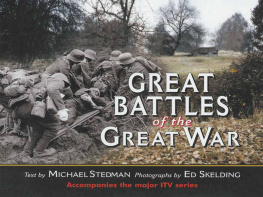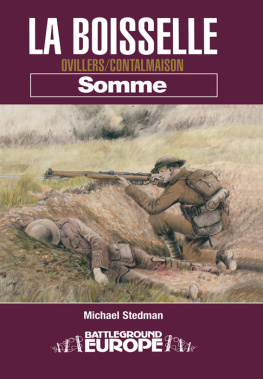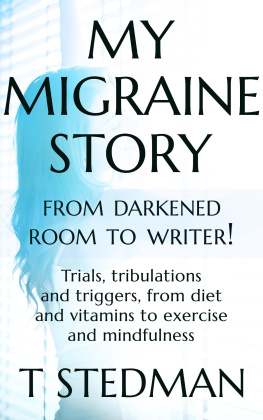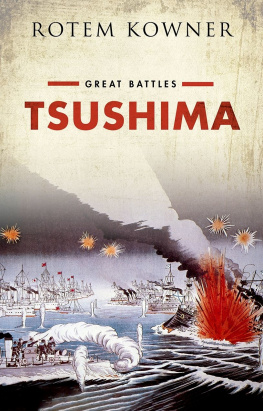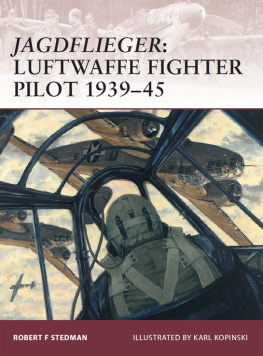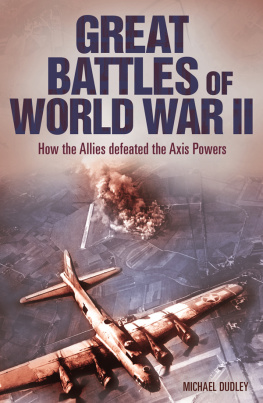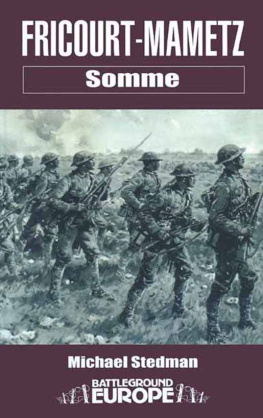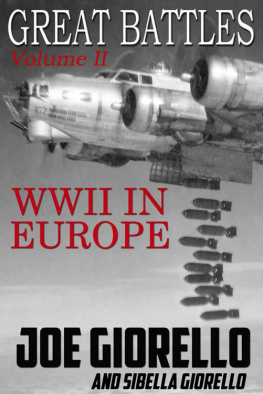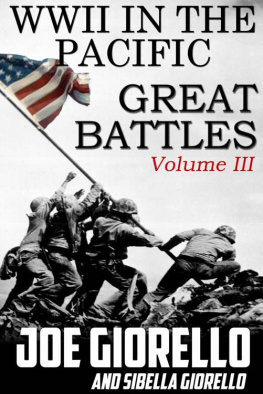Michael Stedman - Great Battles of the Great War
Here you can read online Michael Stedman - Great Battles of the Great War full text of the book (entire story) in english for free. Download pdf and epub, get meaning, cover and reviews about this ebook. publisher: Leo Cooper, genre: History. Description of the work, (preface) as well as reviews are available. Best literature library LitArk.com created for fans of good reading and offers a wide selection of genres:
Romance novel
Science fiction
Adventure
Detective
Science
History
Home and family
Prose
Art
Politics
Computer
Non-fiction
Religion
Business
Children
Humor
Choose a favorite category and find really read worthwhile books. Enjoy immersion in the world of imagination, feel the emotions of the characters or learn something new for yourself, make an fascinating discovery.
- Book:Great Battles of the Great War
- Author:
- Publisher:Leo Cooper
- Genre:
- Rating:4 / 5
- Favourites:Add to favourites
- Your mark:
- 80
- 1
- 2
- 3
- 4
- 5
Great Battles of the Great War: summary, description and annotation
We offer to read an annotation, description, summary or preface (depends on what the author of the book "Great Battles of the Great War" wrote himself). If you haven't found the necessary information about the book — write in the comments, we will try to find it.
Great Battles of the Great War — read online for free the complete book (whole text) full work
Below is the text of the book, divided by pages. System saving the place of the last page read, allows you to conveniently read the book "Great Battles of the Great War" online for free, without having to search again every time where you left off. Put a bookmark, and you can go to the page where you finished reading at any time.
Font size:
Interval:
Bookmark:
GREAT BATTLES OF THE GREAT WAR
Other books by Michael Stedman
Salford Pals: Pals Series
Manchester Pals: Pals Series
Thiepval: Battleground Europe Series
La Boisselle: Battleground Europe Series
Fricourt-Mametz: Battleground Europe Series
Guillemont: Battleground Europe Series
MICHAEL STEDMAN
ED SKELDING
GREAT
BATTLES
of the
GREAT WAR
Accompanies the major ITV series

Leo Cooper
First published in 1999,
reprinted 2000,
by
LEO COOPER
an imprint of
Pen & Sword Books Ltd
47 Church Street
Barnsley
South Yorkshire
S70 2AS
Michael Stedman and Ed Skelding
A CIP catalogue record for this book is available from the British Library
All rights reserved. No part of this publication may be reproduced,
in any form or by any means, without permission from the publishers.
ISBN 0 85052 702 3
Printed in Great Britain by The Bath Press
The Writers perspective
A friend recently reminded me that people who make no study of history are doomed to repeat it. That phrase encapsulates one of the great conundrums of history. All too often we echo its bleakest passages with willing replication.
The Balkans, more than any other place in the last one thousand years, have come to illustrate that quandary of repetion better than most. The first, 11th century, European Crusaders passed this way en route to their appointment with mayhem in the Holy Land The slaughter of Muslim innocents by Christian pilgrims and soldiers who survived that first terrible journey to the prize of Jerusalem has set the subsequent schedule of the Balkans in this meeting place of religious intolerance. This inhospitable corner of south-eastern Europe maintains many deeply ingrained sentiments, many of which are consequential upon the Turkish Ottoman Empires control of parts of the Balkans, Asia and North Africa between the late 13th and early 20th centuries. These predilections still drive many agendas here to this day. It is therefore quite respectable to argue that the North Atlantic Treaty Organisations confrontation with ethnic intolerance in Kosovo, here in the epicentre of the Balkans, has its roots in almost a thousand years of religious tension.
Yet we all know that there is nothing romantic about war. There wasnt in the 11th century and there isnt today.
There is no point in ascribing gentle interpretation to the history of war. As one character within, a remarkable novel which describes the soldiers, experience of the Great War said, Theres too much fin artillery in this bloody warYou dont get no sleep.1 Such grumbling, stoical humour was
This wasnt an accidental occurrence of that meaningless late 20th century phrase friendly fire. It was the certainty of casualties inflicted by our own artillery. That indeed was a very hard lesson to learn.
A glance through the imagery which dominates these pages will help you understand the purpose of this book. It is not a guide-book or travelogue. Nor is it a source of detail in the form of a reference work. What I hope this text and the illustrations provide is a fresh and evocative look at the imagery of the Great War. Clearly it would be foolish to suggest that by reading and viewing the following pages you will have understood the enormous complexity of the Great War. After thirty years of interest and study I would never claim to have fully comprehended all it has to offer. I simply know a little about a small fragment of what happened. However, what I do know for certain is that those four years which ground a grotesque path through the early years of the 20th Centurys history have marked and defined some of the worst fears of man. They were one of the lowest points in a century repeatedly characterised by the pointless slaughter of thousands, sometimes millions, of humans. In response to the ugly brutality of the First World War historians and commentators have generated an enormous body of analytic and descriptive literature. This book is not intended to add to that imponderable quantity of words.
The catalyst of the Great War was death in Sarajevo on 28 June, 1914. The Balkan states, Greece, Albania, Serbia and others, were then, as now, the focus of both western and Russian concern as the gradual collapse of Turkish control left opportunities for Balkan states to argue amongst themselves. Since the late 13th century Turkey had maintained the vast Ottoman Empire by rule from Constantinople, although by 1914 they were not masters of that disparate and far-flung collection of peoples. Two years earlier, in 1912, the Balkan League, comprising Serbia, Montenegro, Bulgaria and Greece, had declared war on Turkey, effectively ending Turkish influence in the area. The following year, 1913, the Balkan pot had overheated again as Serbia and Bulgaria bickered over the territories lost by the Ottoman Empires crumbling. Serbias victory and the sentiment of her strong ethnic links with Russia meant that she became a threat to the stability of the Austro-Hungarian Empire.
There had already been one Bosnian crisis, during 1909, when Russia had failed Serbia and allowed the annexation of this region by the Austro-Hungarians. When the heir to the throne of that empire, Archduke Franz Ferdinand, was assassinated by Gavrilo Princep, a Serbian nationalist, in Sarajevo on 28 June, that single event unleashed the forces of the Great War. An ultimatum was issued to Serbia but its terms were deemed unacceptable. However, Germanys alliance with Austro-Hungary enabled the former to be persuaded of the need to provide support. The Austro-Hungarians were encouraged and declared war on the Serbians. Russia responded in kind with a declaration of war upon Austria-Hungary. This brought forth the involvement of France, Russias ally, and Germany. Britain, though not bound by the terms of any alliance, was soon brought into the conflict when German troops invaded Belgium as part of their plan to defeat the French. Britain, as a guarantor of Belgian neutrality, was incorporated.
The Great War was fact. It was 11.00 pm on 4 August 1914.
Eighty-five years later it seems incredible that, as the 20th century flows into a new millennium, Turkey, Serbia and the explosive ethnic and religious contrasts which mark this part of the world astride the Bosphorus, scene of the ill-fated Gallipoli campaign, are still the focus of our fears.
Within the terrible journey through the slough of despondency which the four years of the Great War became there were many significant battles in what became a global conflict. John Bourne has pointed up the statistics lucidly:
There are some who dispute the status of the Great War as a true World War. This is perverse. The conflict was global. Major wars were fought not only in western, eastern and southern Europe, but also in the Middle East and the Caucasus. A lesser guerrilla war tied down more than 100,000 British Empire troops in East Africa. Surface fleets and submarines contested naval supremacy on and under the oceans of the world. But this was far from all. The insatiable demands of war
The consequences were vast and far-reaching for all the corners of the globe. By the wars end Russia had been plunged into the Bolshevik revolution as a direct consequence of the conflicts impact upon her society The United j States of America had been drawn into the European mle by Germanys ill-advised use of unrestricted submarine warfare. The British Empire way fatally wounded. European monarchies were swept away Boundaries too numerous to contemplate were about to be changed with far-reaching consequences for nations, ethnic groupings and future generations.
Font size:
Interval:
Bookmark:
Similar books «Great Battles of the Great War»
Look at similar books to Great Battles of the Great War. We have selected literature similar in name and meaning in the hope of providing readers with more options to find new, interesting, not yet read works.
Discussion, reviews of the book Great Battles of the Great War and just readers' own opinions. Leave your comments, write what you think about the work, its meaning or the main characters. Specify what exactly you liked and what you didn't like, and why you think so.

